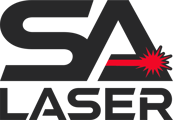Understanding the Key Differences for Laser Engraving and Cutting
Understanding the difference between images and vectors is essential for creating and editing projects in LightBurn. Each format has unique properties that affect laser behavior, job speed, and final quality.
What Are Images and Vectors?
| Images | Vectors |
|---|---|
| Made up of pixels — tiny colored blocks forming a grid. Often called bitmaps or rasters. | Composed of lines and shapes defined by mathematical formulas. |
| Common examples include digital photos, scans, or rendered graphics. | Ideal for creating logos, text, or scalable graphics. |
| Zooming in reveals visible blocks (pixelation). | Zooming in retains perfect quality, no matter the scale. |

|

|
Both images and vectors can be created within LightBurn or imported from compatible file types. Refer to the Importing Guide for details on file compatibility.
Images
Uses and Laser Behavior

Images are used exclusively for engraving. When a laser engraves an image:
- The laser scans side-to-side across the material, creating shading by turning the beam on and off or varying its power.
- Producing an image requires significant time since each line is a fraction of a millimeter apart.
Appearance and Quality
- Images are assigned to a layer in Image Mode. Selected images display a border matching the layer color.
- Enlarging an image may result in noticeable pixelation, reducing quality.
Image Operations
LightBurn provides multiple image processing modes to adjust the engraving result, such as dithering or threshold modes. Choosing the right mode significantly affects the final output.
Vectors
Uses and Laser Behavior
Vectors are versatile and can be used for:
- Cutting: Tracing the vector paths to cut through material.
- Scoring/Marking: Marking lines or perimeters.
- Engraving: Filling areas with lines, similar to how images are engraved.

Layer Modes for Vectors:
- Line Mode: Tells the laser to trace vector paths.
- Fill/Offset Fill: Engraves closed shapes by scanning lines side-by-side. Produces flat colors without gradients or shading.
- Efficiency Tip: Fill Mode takes more time than marking or scoring; consider Line Mode for designs where appropriate.

Editing Vectors in LightBurn
- Simple Paths: Created with tools like Draw Lines and edited using Edit Nodes.
- Built-in Shapes: Include editable objects like text, bar codes, ellipses, rectangles, and polygons. These remain editable unless converted to paths.

View Options:
- By default, Fill Mode layers appear as outlines for easier selection of overlapping vectors.
- Switch view styles via the Window Menu or toggle with Alt/Option+Shift+W.
Converting Between Images and Vectors
Converting Images to Vectors:
- Use Trace Image to convert an image into a vector, often used for clip art or small graphics.
- Note: This process estimates the image and may not always yield the best quality. For engraving, consider using Threshold Mode for better results.
Converting Vectors to Images:
- Use Convert to Bitmap to repair poorly optimized vectors.
- Caution: This process eliminates the scalability and editability of vectors. Repairing the vector directly is often preferable.
Key Takeaways:
- Images are pixel-based and ideal for detailed engravings but can pixelate when scaled.
- Vectors are scalable and versatile, suitable for cutting, scoring, or engraving flat shapes.
- Choose the appropriate format based on the project’s requirements, and leverage LightBurn’s tools to optimize the results.
By understanding the differences between images and vectors, you can better plan and execute your laser projects with precision and efficiency.
